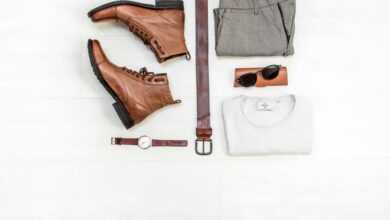
The Fit Pyramid: 5 Easy Checks to Make Any High-Street Piece Look Bespoke
Here’s one of the biggest secrets in menswear, and it costs next to nothing: a £50 jacket that fits you perfectly will always look better than a £500 jacket that doesn’t. We’re often led to believe that dressing well is about buying from expensive brands, but the real hallmark of a stylish man isn’t the label on his clothes; it’s the way they fit his body.
The vast majority of us buy our clothes “off-the-peg” from the high street. This clothing is designed to fit a standardised “average” man who doesn’t actually exist. The result? Shirts that billow at the waist, jacket sleeves that swallow your hands, and trousers that puddle around your ankles. But what if you had a simple, foolproof checklist to use every time you’re in a changing room? A way to instantly assess whether a garment is a hidden gem or a lost cause?
Welcome to the Fit Pyramid. It’s a simple, top-down, five-point check that helps you identify clothes with “good bones.” Master this, and you’ll be able to make affordable, high-street pieces look like they were tailored just for you.
Why Fit is King
Before we climb the pyramid, understand this: a good fit does everything. It creates a stronger, cleaner silhouette. It makes you look leaner and more put-together. It’s the difference between looking like you’ve borrowed your dad’s clothes and looking like you own your style. Now, let’s start the checks, from most to least important.
The Fit Pyramid: Your 5-Point Checklist
Think of this as a top-down assessment, starting with the one thing that’s hardest to change and working your way down to the easiest fixes.
Peak 1: The Shoulders – The Unalterable Foundation
The Check: Look at where the shoulder seam of the shirt, jacket, or coat sits. It should end *exactly* where your shoulder bone ends. Not halfway down your bicep, and not creeping up your neck.
Why it’s the Peak: This is the single most important point of fit on any upper-body garment. The shoulders provide the structure from which everything else hangs. Altering the shoulders of a jacket is incredibly complex and expensive – if a tailor will even agree to do it. If the shoulders don’t fit you perfectly off the peg, put the item back and walk away. It is not the one for you.
The Test: Stand sideways against a wall. If the shoulder pad or seam hits the wall before your actual arm does, the shoulders are too wide.
Level 2: The Chest & Torso – The Clean Drape
The Check: Button up the shirt or jacket. Does it pull into a tight ‘X’ shape across your chest? If so, it’s too tight. Now, stand relaxed. Is there more than a few inches of excess fabric billowing at your sides or back? If so, it’s too big.
Why it Matters: A clean drape across the chest and a gentle taper at the waist is what creates a sharp silhouette. A tight chest makes you look constrained, while excess fabric makes you look shapeless.
The Tailor-ability: This is a relatively easy and common fix. A tailor can easily add “darts” to the back of a shirt or take in the side seams of a jacket to remove excess fabric and create that crucial V-shape. It’s a high-impact, low-cost alteration.
Level 3: Sleeve Length – The Polished Finish
The Check: With your arms relaxed at your sides, check where the sleeves end.
- For a shirt: The cuff should end right at your wrist bone, where your hand begins.
- For a jacket or blazer: The sleeve should be slightly shorter, ending about half an inch above your shirt cuff, allowing a sliver of shirt to peek out.
Why it Matters: Sleeves that are too long look sloppy and swamp your frame. Sleeves that are too short can look comical. Getting this right is a huge sign of a well-fitting garment.
The Tailor-ability: One of the easiest and cheapest fixes in the book. Shortening sleeves is a simple job for any tailor.
Level 4: Overall Length (Hem) – The Proportional Balance
The Check: How long is the garment itself?
- For a casual shirt (to be worn untucked): The hem should end roughly mid-way down your trouser fly. Any longer and it looks like a dress; any shorter and you’ll be showing off your belly every time you raise your arms.
- For a jacket/blazer: The hem should typically cover your seat (your bum).
Why it Matters: The length of a garment dramatically affects your perceived proportions. A jacket that’s too long can make your legs look short, and vice versa.
The Tailor-ability: Shortening a shirt is easy. Shortening a jacket is more complex but usually doable. Lengthening is almost never an option.
Base 5: The Trousers – The Final Foundation
The Check: For trousers, focus on two things: the fit in the seat/thighs and the length.
- The Fit: You should be able to pinch about an inch of fabric on either side of your thigh. They shouldn’t be skin-tight nor excessively baggy.
- The Length (The “Break”): This refers to the fold of fabric that forms at the bottom of your trousers where they meet your shoes. For a modern, clean look, aim for a “slight break” (one small fold) or “no break” (the hem just kisses the top of your shoes). Avoid the messy pile-up of fabric known as the “full break.”
Why it Matters: A clean line from your waist to your shoes makes you look taller and sharper. Sloppy, puddling trousers are a style killer.
The Tailor-ability: The easiest fixes of all. Taking in the waist or hemming the length is cheap, quick, and makes an enormous difference.
Your Secret Weapon: The Local Tailor
Once you’ve used the Fit Pyramid to buy a piece with good bones (perfect shoulders!), the final step is to invest a little extra to perfect it. Find a local dry cleaner that offers an alteration service. For £10-£20, you can get trousers hemmed or a shirt darted. This small investment is what elevates a £30 high-street shirt into something that looks and feels like it was made for you.
Next time you’re shopping, arm yourself with the Fit Pyramid. Start at the top with the shoulders and work your way down. It’s a simple, repeatable process that will stop you from wasting money on ill-fitting clothes and empower you to build a wardrobe that truly fits. Remember, style isn’t about the price tag; it’s about the fit. Happy (and smarter) shopping, chaps!




